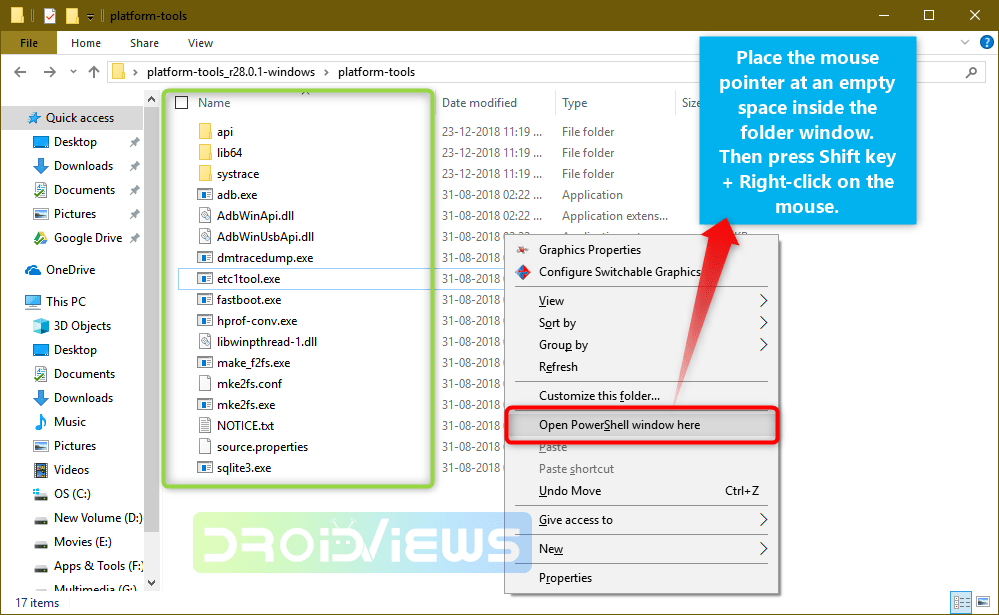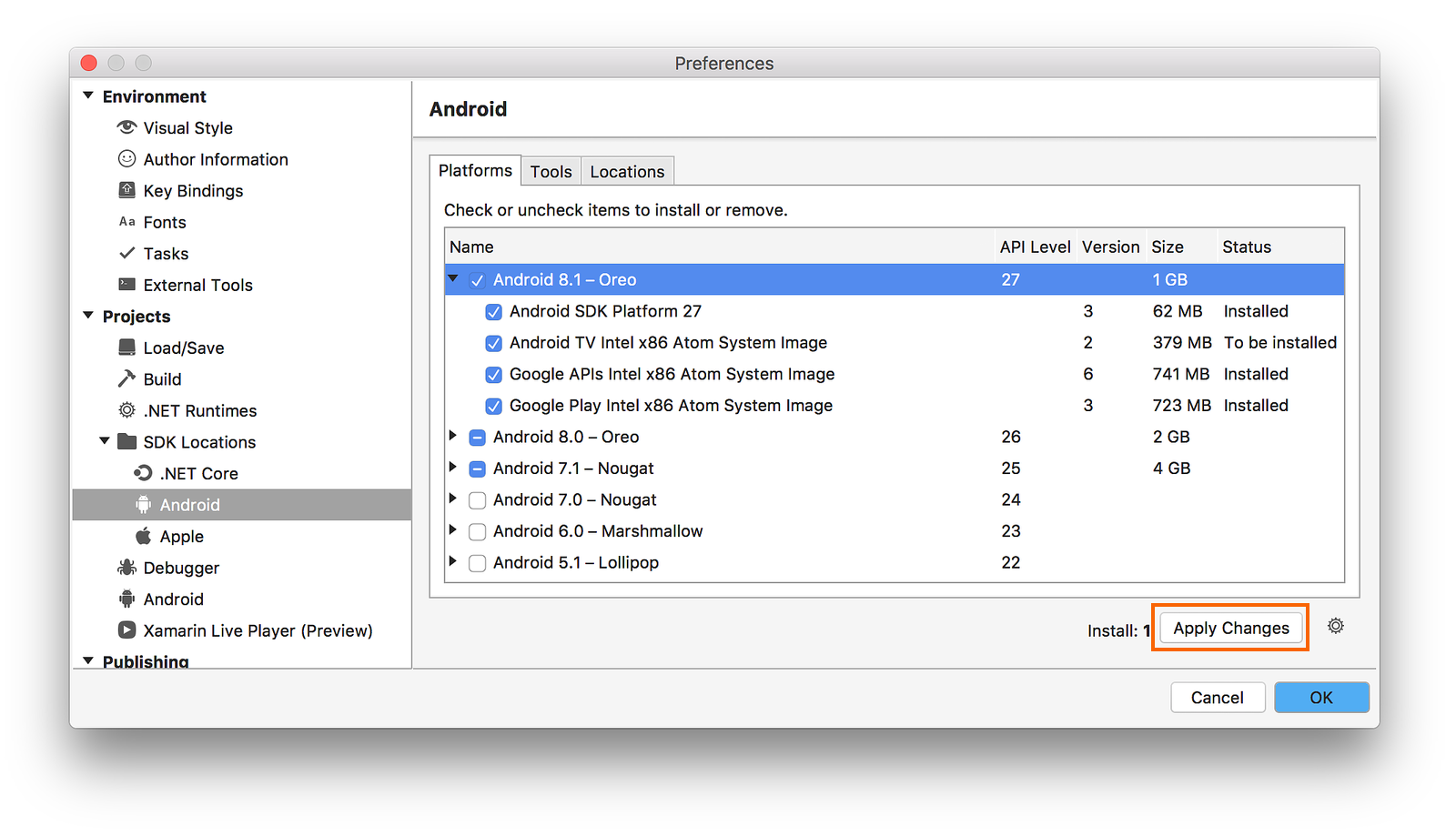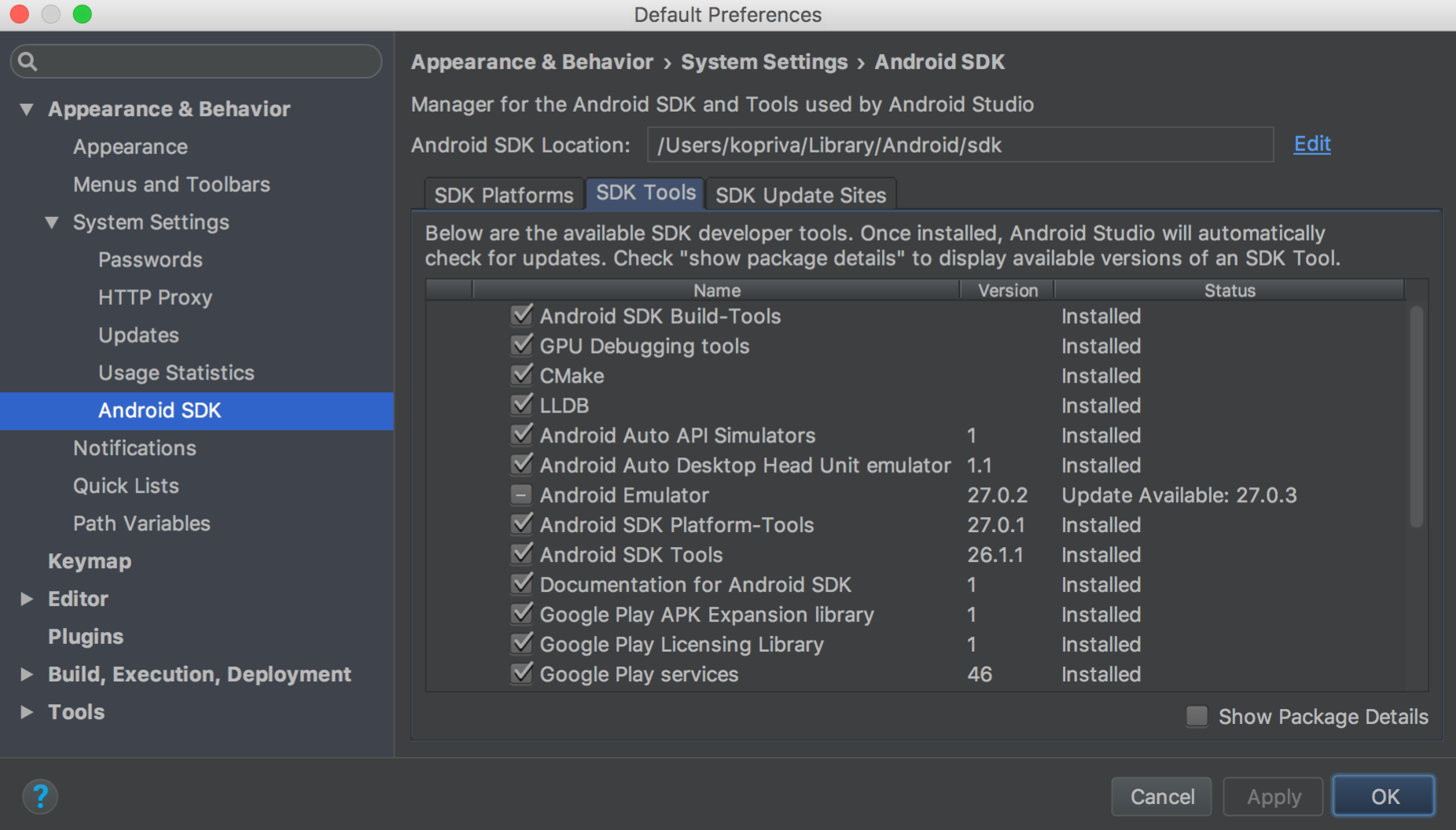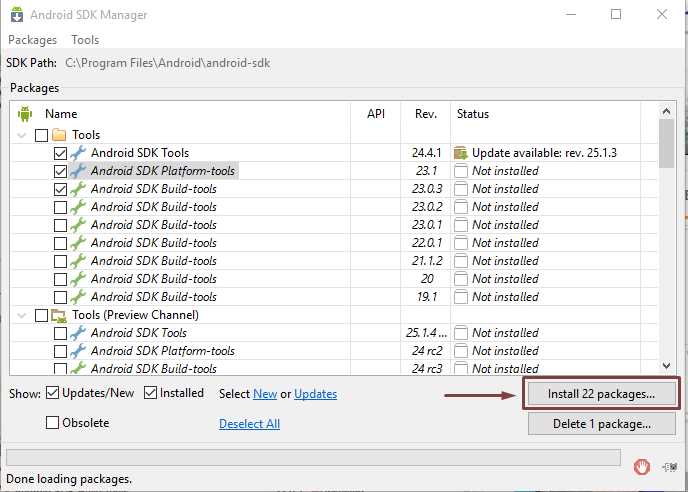- Android Sdk Tools Download For Windows 10
- Android Sdk Platform Tools Download Offline
- Android Sdk Platform Tools Package Download
Android SDK Platform Tools download is now available as a zip file directly from Google. Just download the latest SDK platform-tools zip containing ADB and Fastboot binaries for Windows, Mac, and Linux from below and unzip it. Android SDK Tools 30.0.5 is available to all software users as a free download for Windows 10 PCs but also without a hitch on Windows 7 and Windows 8. Compatibility with this software may vary, but will generally run fine under Microsoft Windows 10, Windows 8, Windows 8.1, Windows 7, Windows Vista and Windows XP on either a 32-bit or 64-bit setup. If you're an Android developer, you should get the latest SDK Platform-Tools from Android Studio's SDK Manager or from the sdkmanager command-line tool. This ensures the tools are saved to the right place with the rest of your Android SDK tools and easily updated. But if you want just these command-line tools, use the following links.
Android SDK Tools latest download offline installer 2020 free for Windows. Download Android SDK tools and SDK platform tools for free. It is compatible with Windows 7, 8, 8.1, 10, XP, and Vista. Both 32 bit and 64 bit operating systems of all versions of Windows supports Android SDK Tools. There are different packages of Android SDK such as SDK tools, SDK platform, SDK platform tools, Documentations, system images, samples for SDK, Google APIs, Source for Android SDK, Google play billing, Play store licensing, and Android support. All these bundles can be downloaded as full package from official site by following the given option “check for new version” below. The given SDK Tools contains 133MB file volume which you can download for free.
Android SDK Tools Download Offline
In April, 2017 developers of Android has released the latest version v26.0.2 of Android SDK Tools. It is the most recent revision release. Android SDK tools are open source tools from Android developers. Anyone can download full offline package from below here for PC Windows only.
After installation of this latest package, when a new version will be released. You can update it to new version using Android SDK manager. You can keep up to date with the latest release all time. Once you will download Android SDK Tools offline installer, you can install it on any computer without having any problem.
SDK Tools is helpful to develop an Android new app. It is also a debugging, and testing tool for Android platforms. It contains all utilities that require to develop an Android application. Keep always up to date SDK tools to get better results.
The SDK tools offline installer, and online installer are available on developers.android.com. You can download SDK tools offline installer at the bottom of this page. You can download it and install on Window. If you are looking SDK Tools for;
- Linux, and
- Mac
follow the “check for new version” option below, where you can check for new available version of Android SDK tools. You can download the latest released for Windows, Linux, and Mac.
Download | Check for new version
 -->
-->Visual Studio includes an Android SDK Manager that you useto download Android SDK tools, platforms, and other components that youneed for developing Xamarin.Android apps.
Overview
This guide explains how to use the Xamarin Android SDK Manager inVisual Studio and Visual Studio for Mac.
Note
This guide applies to Visual Studio 2019, Visual Studio 2017, and Visual Studio for Mac.
The Xamarin Android SDK Manager (installed as part of the Mobiledevelopment with .NET workload) helps you download the latest Androidcomponents that you need for developing your Xamarin.Android app. Itreplaces Google's standalone SDK Manager, which has been deprecated.

Requirements
To use the Xamarin Android SDK Manager, you will need the following:

Visual Studio 2019 Community, Professional, or Enterprise.
OR Visual Studio 2017 (Community, Professional, or Enterprise edition). VisualStudio 2017 version 15.7 or later is required.
Visual Studio Tools for Xamarin version 4.10.0 or later(installed as part of the Mobile development with .NET workload).
The Xamarin Android SDK Manager also requires the Java Development Kit(which is automatically installed with Xamarin.Android). There areseveral JDK alternatives to choose from:
By default, Xamarin.Android usesJDK 8,which is required if you are developing for API level 24 or greater(JDK 8 also supports API levels earlier than 24).
You can continue to use JDK 7if you are developing specifically for API level 23 or earlier.
If you are using Visual Studio 15.8 Preview 5 or later, you can tryusing Microsoft's Mobile OpenJDK Distributionrather than JDK 8.
SDK Manager
To start the SDK Manager in Visual Studio, click Tools > Android >Android SDK Manager:
The Android SDK Manager opens in the Android SDKs andTools screen. This screen has two tabs – Platforms andTools:
The Android SDKs and Tools screen is described in more detail inthe following sections.
Android SDK location
The Android SDK location is configured at the top of the Android SDKsand Tools screen, as seen in the previous screenshot. This location mustbe configured correctly before the Platforms and Tools tabswill function properly. You may need to set the location of the AndroidSDK for one or more of the following reasons:
The Android SDK Manager was unable to locate the Android SDK.
You have installed the Android SDK in a alternate (non-default) location.
To set the location of the Android SDK, click the ellipsis (…)button to the far right of Android SDK Location. This opens theBrowse For Folder dialog to use for navigating to the location ofthe Android SDK. In the following screenshot, the Android SDK underProgram Files (x86)Android is being selected:
When you click OK, the SDK Manager will manage the Android SDK thatis installed at the selected location.
Tools tab
The Tools tab displays a list of tools and extras. Use this tabto install the Android SDK tools, platform tools, and build tools.Also, you can install the Android Emulator, the low-level debugger(LLDB), the NDK, HAXM acceleration, and Google Play libraries.
For example, to download the Google Android Emulator package, click thecheck mark next to Android Emulator and click the Apply Changesbutton:
A dialog may be shown with the message, The following package requiresthat you accept its license terms before installing:
Click Accept if you accept the Terms and Conditions. At the bottomof the window, a progress bar indicates download and installationprogress. After the installation completes, the Tools tab will showthat the selected tools and extras were installed.
Platforms tab
The Platforms tab displays a list of platform SDK versions alongwith other resources (like system images) for each platform:
This screen lists the Android version (such as Android 8.0), thecode name (Oreo), the API level (such as 26), and the sizes ofthe components for that platform (such as 1 GB). You use thePlatforms tab to install components for the Android API level thatyou want to target. For more information about Android versions and APIlevels, seeUnderstanding Android API Levels.
When all components of a platform are installed, a checkmark appears nextto the platform name. If not all components of a platform areinstalled, the box for that platform is filled.You can expand a platform to see its components (and which componentsare installed) by clicking the + box to the left of the platform.Click - to unexpand the component listing for a platform.
To add another platform to the SDK, click the box next to the platformuntil the checkmark appears to install all of its components, thenclick Apply Changes:
To install only specific components, click the box next to the platformonce. You can then select any individual components that you need:
Notice that the number of components to install appears next to theApply Changes button. After you click the Apply Changes button,you will see the License Acceptance screen as shown earlier.Click Accept if you accept the Terms and Conditions. You may seethis dialog more than one time when there are multiple components toinstall. At the bottom of the window, a progress bar will indicatedownload and installation progress. When the download and installationprocess completes (this can take many minutes, depending on how manycomponents need to be downloaded), the added components are marked witha checkmark and listed as Installed.
Repository selection
By default, the Android SDK Manager downloads platform components andtools from a Microsoft-managed repository. If you need access toexperimental alpha/beta platforms and tools that are not yet availablein the Microsoft repository, you can switch the SDK Manager to useGoogle's repository. To make this switch, click the gear icon in thelower right-hand corner and select Repository > Google(Unsupported):
When the Google repository is selected, additional packages may appearin the Platforms tab that were not available previously. (In theabove screenshot, Android SDK Platform 28 was added by switching tothe Google repository.) Keep in mind that use of the Google repositoryis unsupported and is therefore not recommended for everydaydevelopment.
To switch back to the supported repository of platforms and tools,click Microsoft (Recommended). This restores the list of packagesand tools to the default selection.
Requirements
To use the Xamarin Android SDK Manager, you will need the following:
- Visual Studio for Mac 7.5 (or later).
The Xamarin Android SDK Manager also requires the Java Development Kit(which is automatically installed with Xamarin.Android). There areseveral JDK alternatives to choose from:
By default, Xamarin.Android usesJDK 8,which is required if you are developing for API level 24 or greater(JDK 8 also supports API levels earlier than 24).
You can continue to use JDK 7if you are developing specifically for API level 23 or earlier.
If you are using Visual Studio for Mac 7.7 or later, you can tryusing Microsoft's Mobile OpenJDK Distributionrather than JDK 8.
Important

Xamarin.Android does not support JDK 9.

SDK Manager
To start the SDK Manager in Visual Studio for Mac, click Tools > SDK Manager:
The Android SDK Manager opens in the Preferences window, whichcontains three tabs, Platforms, Tools, and Locations:
The tabs of the Android SDK Manager are described in thefollowing sections.
Locations tab
The Locations tab has three settings for configuring the locationsof the Android SDK, Android NDK, and the Java SDK (JDK). Theselocations must be configured correctly before the Platforms andTools tabs will function properly.
When the SDK Manager starts, it automatically determines the path foreach installed package and indicates that it was Found by placing agreen checkmark icon next to the path:
Click the Reset to Defaults button to cause the SDK Manager to lookfor the SDK, NDK, and JDK at their default locations.
Typically, you use the Locations tab to modify the location of theAndroid SDK and/or the Java JDK. You do not need to install the NDK todevelop Xamarin.Android apps – the NDK is used only when you needto develop parts of your app using native-code languages such as C andC++.
Tools tab
The Tools tab displays a list of tools and extras. Use this tabto install the Android SDK tools, platform tools, and build tools.Also, you can install the Android Emulator, the low-level debugger(LLDB), the NDK, HAXM acceleration, and Google Play libraries.
For example, to download the Google Android Emulator package, click thecheck mark next to Android Emulator and click the Apply Changesbutton:
A dialog may be shown with the message, The following package requiresthat you accept its license terms before installing:
Click Accept if you accept the Terms and Conditions. At the bottomof the window, a progress bar indicates download and installationprogress. After the installation completes, the Tools tab will showthat the selected tools and extras were installed.
Platforms tab
The Platforms tab displays a list of platform SDK versions alongwith other resources (like system images) for each platform:
This screen lists the Android version (such as Android 8.1), thecode name (Oreo), the API level (such as 27), and the sizes ofthe components for that platform (such as 1 GB). You use thePlatforms tab to install components for the Android API level thatyou want to target. For more information about Android versions and APIlevels, see Understanding Android API Levels.
When all components of a platform are installed, a checkmark appears nextto the platform name. If not all components of a platform areinstalled, the box for that platform is filled.You can expand a platform to see its components (and which componentsare installed) by clicking the arrow to the left of the platform.Click down arrow to unexpand the component listing for a platform.
To add another platform to the SDK, click the box next to the platformuntil the checkmark appears to install all of its components, thenclick Apply Changes:
To install only some components, click the box next to the platformonce. You can then select any individual components that you need:
Notice that the number of components to install appears next to theApply Changes button. After you click the Apply Changes button,you will see the License Acceptance screen as shown earlier.Click Accept if you accept the Terms and Conditions. You may seethis dialog more than one time when there are multiple components toinstall. At the bottom of the window, a progress bar will indicatedownload and installation progress. When the download and installationprocess completes (this can take many minutes, depending on how manycomponents need to be downloaded), the added components are marked witha checkmark and listed as Installed.
Repository selection
Android Sdk Tools Download For Windows 10
By default, the Android SDK Manager downloads platform components andtools from a Microsoft-managed repository. If you need access toexperimental alpha/beta platforms and tools that are not yet availablein the Microsoft repository, you can switch the SDK Manager to useGoogle's repository. To make this switch, click the gear icon in thelower right-hand corner and select Repository > Google(Unsupported):
When the Google repository is selected, additional packages may appearin the Platforms tab that were not available previously. (In theabove screenshot, Android SDK Platform 28 was added by switching tothe Google repository.) Keep in mind that use of the Google repository isunsupported and is therefore not recommended for everyday development.
To switch back to the supported repository of platforms and tools,click Microsoft (Recommended). This restores the list of packagesand tools to the default selection.
Android Sdk Platform Tools Download Offline
Summary
Android Sdk Platform Tools Package Download
This guide explained how to install and use the Xamarin Android SDKManager tool in Visual Studio and Visual Studio for Mac.
Related Links
